by Jonathan Gagne
Jesse Lambert, a member of my Telegram channel, recently drew my attention to a really interesting physics paper by Knight, Jaeger & Nagel that I now think may be relevant to our understanding of fines migration in coffee brewing. There are some considerations that could complicate its application to coffee, but I’ll come back to those at the end of the post.
First, let me summarize my view of fines migration before I had read that paper. You might remember that when we discuss the size distribution of coffee particles, we often call the smallest ones fines and the largest ones boulders. When we use the word migration in this context, we usually refer to fines preferentially moving towards the bottom of the coffee bed during a brew. This is also sometimes called the Brazil nut effect because fragments will tend to accumulate at the bottom of a container where dry food is stored.
This phenomenon of fines moving toward the bottom of the coffee bed is mostly relevant to percolation methods, i.e. those where we pour water on top the coffee and use the grounds themselves as part of the filtration system. We worry about this because the accumulation of fines near the filter that holds the coffee bed together might get enough of its pores blocked to cause clogging. When a filter clogs, it will slow down the flow of water in a poorly controlled way, and this will also result in a less evenly distributed flow and therefore extraction through the coffee bed. If you’re interested to read more about this, see this previous post I wrote on the subject.
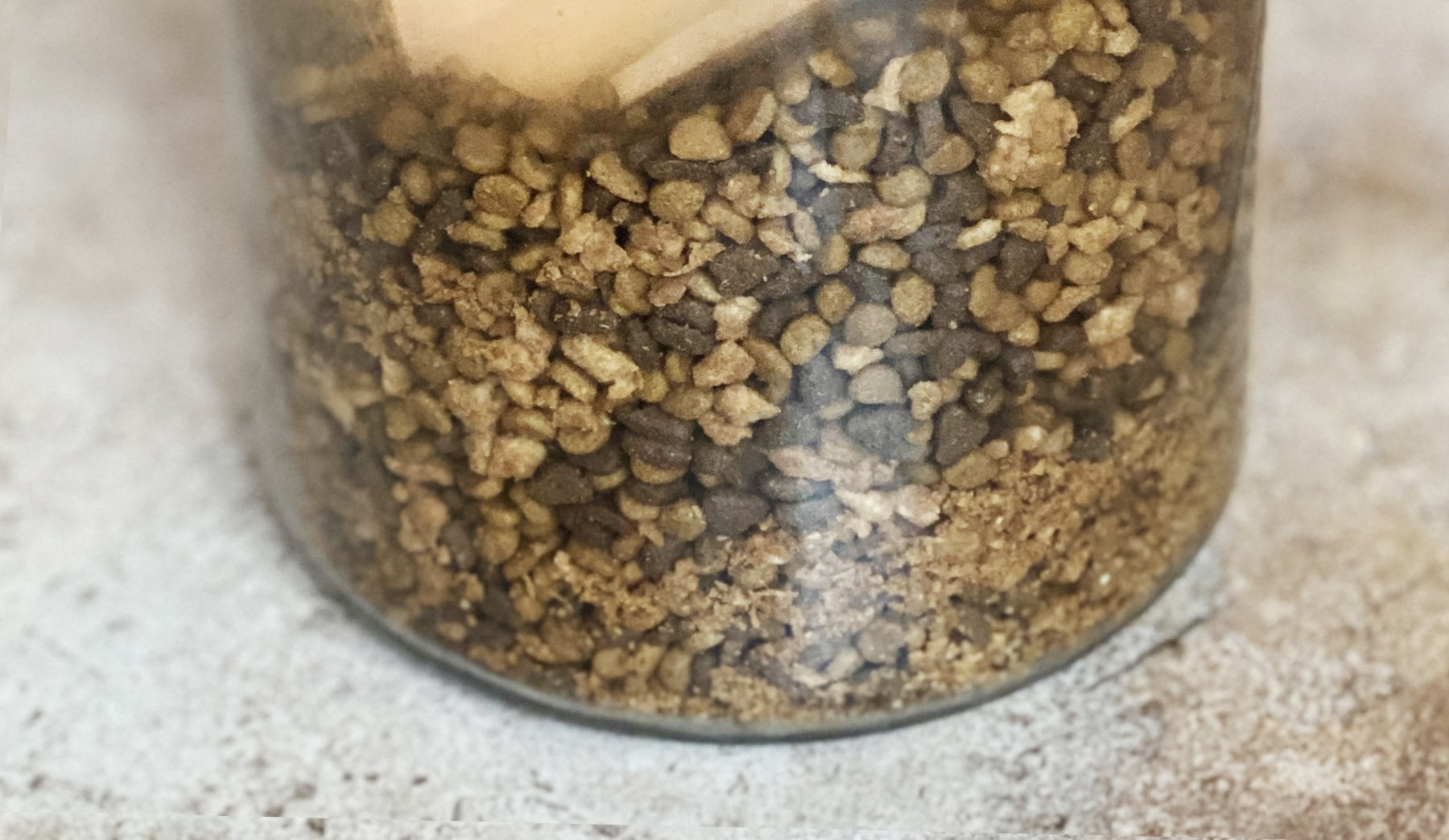 The Brazil nut effect observed in a jar of cat food. The smaller fragments tend to accumulate at the bottom of the jar.
The Brazil nut effect observed in a jar of cat food. The smaller fragments tend to accumulate at the bottom of the jar.
My previous understanding of how fines migration occurred was that, in the presence of vibrations strong enough to lift coffee boulders, some larger gaps between them would appear momentarily and allow fines to fall through toward the bottom. This video shows this mechanism in action. While it can still happen, the key finding of the Knight paper is that this effect is not required for fines migration to occur ! Even if the vibrations are too weak to lift the boulders or cause them to jump around, a whole different mechanism can still cause the fines to clog the pores of your coffee filter, and its details are incredibly interesting.
To figure this out, the team of scientists led by Knight placed identically shaped glass balls in a cylindrical container, and added a single larger ball with the same mass density as the other ones. They painted the large ball and a couple of small ones with a bright color so that they could easily track their displacements, and they attached a device to the container that can imitate a short tap in a very controllable way. This way, they could artificially tap the container as many times as they like, always with the same exact force and duration. All they then had to do is turn on the tapping and observe how the colored balls moved around. To the scientists’ surprise, no ball actually needed to be lifted for anything to happen. Instead, the balls near the edges of the container were pushed down by the frictional forces of the walls vibrating against the balls, which started a cyclic flow in the whole container that looks very much like convection in a hot liquid.
 The image above displays a temporal sequence of motion in a cylindrical container as it is tapped many times. Some of the balls were colored to keep track of their motion. The balls against the walls flow downward, and push the central particles upward, starting a convection-like cyclical flow. Source: Knight et al. (1993), modified.
The image above displays a temporal sequence of motion in a cylindrical container as it is tapped many times. Some of the balls were colored to keep track of their motion. The balls against the walls flow downward, and push the central particles upward, starting a convection-like cyclical flow. Source: Knight et al. (1993), modified.
As you can see in the image above, the glass balls that are incoming from above are pushing the bottom layer of balls toward the center of the container, and those are in turn pushing the bottom center balls upward. When they reach the surface, they migrate outward to the container walls, and that completes the cycle where they get pushed down again by the vibration.
In nature, convection can be observed in all kinds of places where a fluid is quickly heated; at the surface of the Sun, in a boiling pot of water, in a hot Miso soup especially just after you remove its lid, or even in a small cup of tea in a cool environment with the right lighting. I don’t think the motion of the balls can be called proper convection, but they sure move in a very similar way.
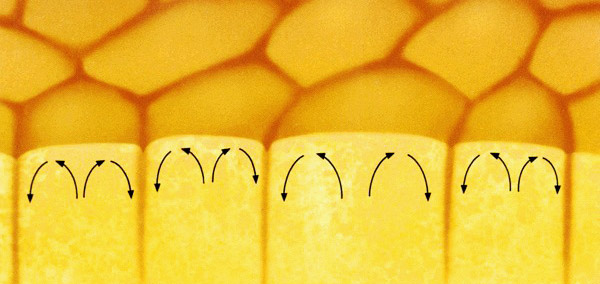 The image above shows convection cells at the surface of the Sun. Large bubbles of (brighter) hot gas flow upward and thin layers of (fainter) cool gas flow downward between the bubbles. The cyclical nature of this flow is similar to what is observed in a tapped cylinder of glass balls. Source: University of Wisconsin, Madison.
The image above shows convection cells at the surface of the Sun. Large bubbles of (brighter) hot gas flow upward and thin layers of (fainter) cool gas flow downward between the bubbles. The cyclical nature of this flow is similar to what is observed in a tapped cylinder of glass balls. Source: University of Wisconsin, Madison.
In the image above, you can see convection taking place at the surface of the Sun; the cells of upward-moving hot fluid and the interstices of slightly cooler, downward-moving fluid look similar to the container of glass balls. In fact, the latter almost looks like a large convection cell going up at the center of the cylinder.
If all balls had the same size, the result would be a slow and cyclical motion around the container. But something goes haywire when the larger glass ball gets near the cylinder wall at the top layer. It is too large to fit in the downward flow, and it gets stuck at the top layer. If you had many large balls, they would eventually all get trapped near the top of the container. If you imagine a large amount of large nuts with some amount of nut fragments, you would end up with all the powder at the bottom after a little while, and therefore observe the Brazil nut effect.
To verify their hypothesis that the whole flows were driven by friction with the container walls, they repeated the experiment using a container with a rough and a smooth side. The rough side provides a lot more friction, and as they expected it drove a much more important downward flow near the rough edge of the container wall:
 In the image above, the right side of the cylindrical container is rough and provides friction, whereas the left side is smooth and provides almost no friction. As a consequence, the downward flow only happens on the right side. Source: Knight et al. (1993).
In the image above, the right side of the cylindrical container is rough and provides friction, whereas the left side is smooth and provides almost no friction. As a consequence, the downward flow only happens on the right side. Source: Knight et al. (1993).
The team of scientists did not stop there. They decided to test another container shape, and quite amazingly they chose to study the behavior of a cone, making this very relevant to V60 brews ! They repeated the same experiment, and observed something shocking. The flow reversed entirely, and this caused the larger balls to get trapped at the bottom, instead of the surface!
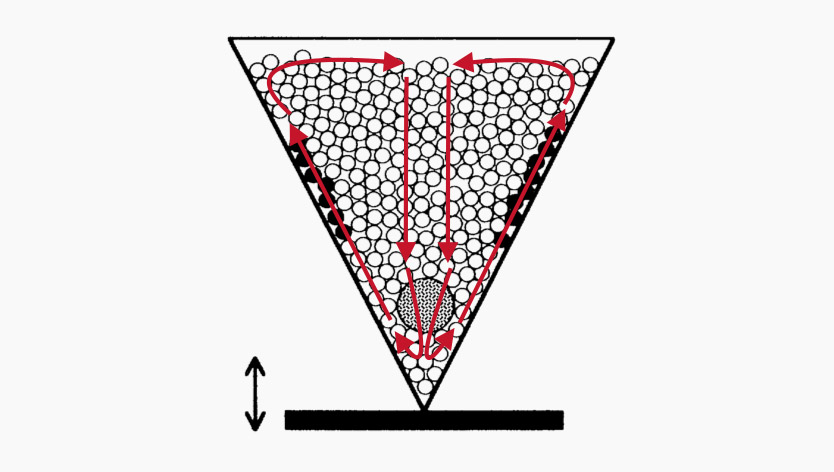 A conical container reverses the direction of the convection-like flows, causing the larger balls to get stuck at the bottom. Source: Knight et al. (1993), modified.
A conical container reverses the direction of the convection-like flows, causing the larger balls to get stuck at the bottom. Source: Knight et al. (1993), modified.
They also observed that the thickness of the upward edge flow was a bit larger compared to the cylinder case. In principle, this could mean slightly larger boulders can complete the full cycle rather than get stuck somewhere, compared to the cylinder case.
Another science paper by Hejmady and co-authors showed this beautiful sequence of how layers of colored spheres evolve with vibration to bring out the details of the flow structure:
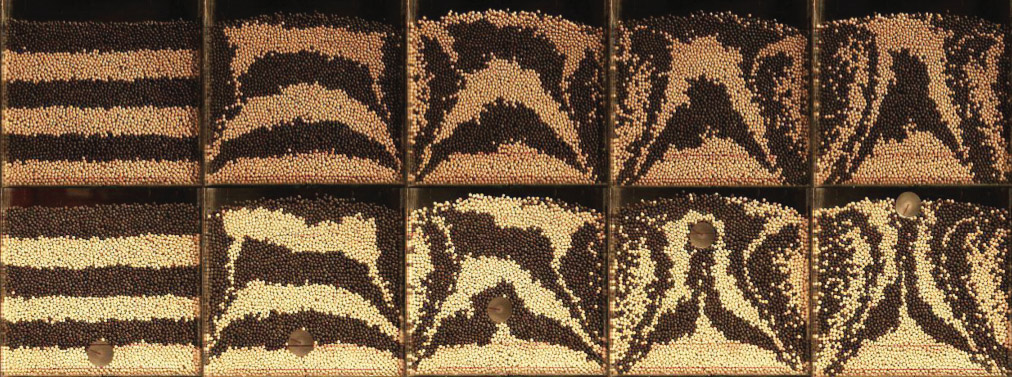 Top layer of photos: temporal sequence of how vibrations affect layers of colored balls. Bottom layer: similar with the exception of a large ball that is included to show how it gets trapped at the surface. Source: Hejmady et al. (2012).
Top layer of photos: temporal sequence of how vibrations affect layers of colored balls. Bottom layer: similar with the exception of a large ball that is included to show how it gets trapped at the surface. Source: Hejmady et al. (2012).
They also show a nice visualization of the flow direction in a superposed image similar to a long-exposure photo:
This video also shows a great visualization of the phenomenon.
With all these results in mind, you might think that a V-shaped container might work against clogging a filter because it would concentrate the boulders at the bottom instead of the fines, but that’s besides the point because the fines circulating around the edges of the paper filter would contribute to clogging it, regardless of the direction in which they are flowing. Fines small enough to penetrate the pores of the paper filter will get stuck in it, so any kind of motion that brings more fines in the vicinity of the filter will contribute to reach the point where the filter clogs. In other words, tapping either a conical or cylindrical filter will contribute to clogging the filter, even if they trap the boulders in different regions of the coffee bed.
These concepts could also be applied to coffee brewing in a couple more ways:
– A vibrating cylinder could be used to lift boulders to the top of a dose of ground coffee to scoop it out and make the particle distribution narrower. This would be similar to sifting, but might be a bit more convenient and faster. It would probably share some of the disadvantages of sifting however, for example it would probably be messy and hard to replicate exactly.
– The wall angles of a conical brewer could probably be chosen to minimize any displacement of particles in the brewer even in the presence of vibrations. As the Knight paper discusses, the fact that the very slanted walls reverse the flow probably means that there is one geometry with less slanted walls, in between this particular cone and a cylinder, which would stop all ball motion. Very smooth edges could also achieve this, but remember that the edges of a coffee bed are the paper filter itself, and it seems implausible to have a very smooth, frictionless paper filter.
– If we had a filter that cannot be clogged, we could use this re-organization of the coffee bed particles to make extraction more even. Normally, the bottom of the coffee bed only comes in contact with concentrated water, and this causes the bottom to extract less and in a different way: it will preferentially extract chemicals that are not already dissolved in water, see this previous post I wrote for more about this. Conical brewers partly make up for this by having a larger amount of water pass through the bottom of the coffee bed because of their geometry, and this prevents the bottom from being under-extracted. This is an imperfect solution however, because the bottom of the coffee bed still extracts in a different way. Using vibration to re-organize the coffee bed without clogging the filter would be amazing, but a real challenge: it would require both the coffee particle distribution to be very even, and the filter pores to also be very even and smaller than the coffee particles.
It’s important to keep in mind that these papers are based on idealized scenario which could make their application to coffee brewing less straightforward. Here are some caveats I could think about, but there may be more:
– The presence of water in the brewer provides additional forces (dragging along the currents and upward buoyancy) that may introduce different displacements of the coffee particles. In the presence of vibration, the flow of particles described above probably still happens, but it could be washed away by stronger effects.
– The scientists that carried these experiments used a very specific type of tapping with a single 30 Hz frequency vibration. It’s possible that changing that frequency might affect the strength or even the direction of particle flows. In practice, finger tapping might cause vibrations of different and even varying frequencies.
– The shapes of coffee particles are far from being spherical, which could affect these results. Similarly, in real scenarios we have a wide variety of particle sizes, not just uniform small particles and one large particle. I think those effects are less likely an issue, because convection-type flows are observed even in containers of unevenly shaped and sized nuts and dry foods.
– It’s important to keep in mind that strong vibrations or upward forces can still lift boulders and cause fines to fall in between the cracks. This means that even in a scenario where the geometry of a container prevents convection-like displacements, this alternative type of fines migration could still happen.
I’m hoping you found these results as interesting as I did ! I’d like to thank Jesse Lambert for digging up these papers too!
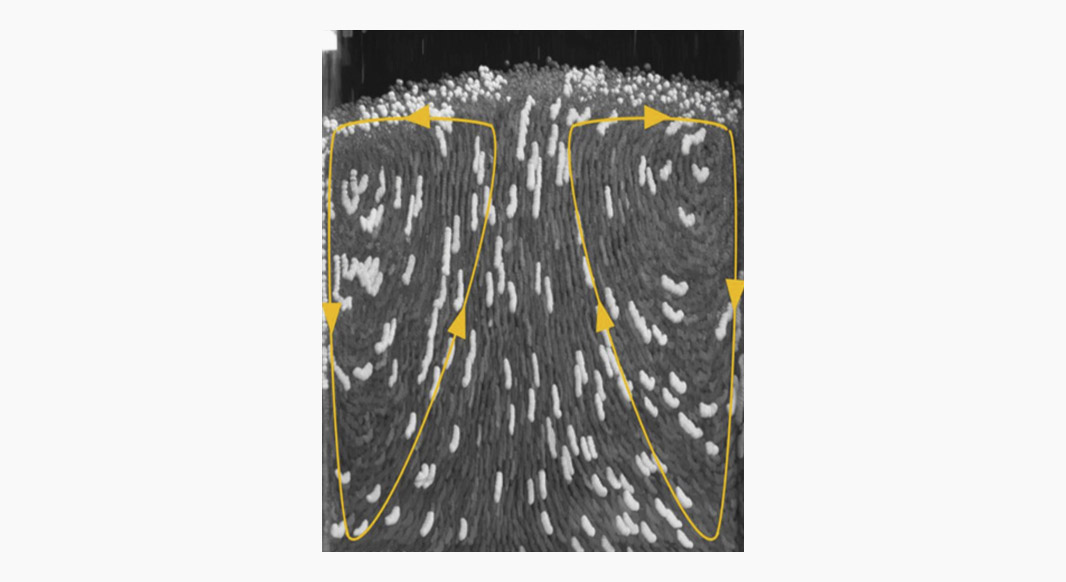



0 Comments